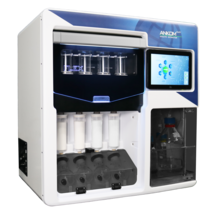Vitamins A, E, D, and K & Cholesterol Analysis
Vitamins
Fat-Solubility
Fat-soluble vitamins such as A, E, D, and K are integral to human wellness. Dissolved by fat and stored in tissue for access when needed, the body draws upon these vitamins for vital processes. Vitamin deficiencies and toxicities can cause many health problems and chronic diseases, affecting one’s quality of life. Achieving accurate and precise determinations of these nutrients is important for public health and buyer awareness. Government agencies, food manufacturers, and academic researchers are often at the forefront of such analyses.
Vitamin A
The fat-soluble vitamin A is naturally present in a host of animal and plant foods. A vital nutrient for healthy eyesight and organ function, vitamin A is composed of organic compounds such as retinol, retinal, and carotenoid beta-carotene.
Vitamin E
Benefitting blood, brain, and skin health through cell membrane support, vitamin E can be found primarily in plant products, such as nuts and oils. Like vitamin A, vitamin E possesses antioxidant properties, working hard to fight against the presence of harmful free radical chemicals in the body.
Vitamin D
Vitamin D, made up of fat-soluble secosteroids, encourages the intestine’s absorption of nutrients such as calcium, phosphate, and magnesium. A healthy presence of Vitamin D in the body ensures balanced skeletal formation in young children and calcium maintenance in the aging to prevent osteoporosis.
Vitamin K
Vitamin K, when partnered with its dependent enzyme carboxylase, supports blood clotting in the body. Vitamin K is absorbed in the small intestine and sent throughout the body for storage and use. Foods like leafy green vegetables, fruits, and vegetable oils contain this vitamin. Food regulators have determined healthy intake values for vitamin K, as deficiency could lead to blood and bone conditions.
Cholesterol Analysis
Cholesterol is isolated via the processes of saponification and extraction and quantified by gas chromatography (GC). Classical methods, while straightforward, require many steps to complete the isolation of cholesterol from a sample.
Cholesterol Value
A substance trafficked through the blood; cholesterol is a key factor in the body’s healthy cell production. However, too much cholesterol can elevate one’s risk for heart disease. Ascertaining the correct cholesterol values in foods and feed is vital for food production, regulation, and nutritional labeling.
Analyzing Fat-Soluble Compounds
Fat-soluble vitamins are isolated by saponification and extraction. Once these steps are complete, the isolate is reconstituted and quantified by liquid or gas chromatography.
Saponification
To quantify the true vitamin content, fat-soluble esters and complexes must be broken to liberate target analytes. In this digestion process, known as saponification, certain chemical complexes are broken down by mixing potassium hydroxide (KOH) and ethanol under elevated temperatures for a determined amount of time. Various methods will employ different combinations of time and temperature treatments.
Extraction
Once a sample has been saponified, it becomes an aqueous mixture of free fatty acids, vitamins, cholesterol, and other nutrients. Extraction of the target analyte from the saponified solution is done by using a non-polar solvent, such as hexane, which will not mix with the polar saponified solution. Analyte extraction is usually done through two different extraction processes: Liquid-liquid extraction and solid phase extraction (SPE). In the liquid-liquid extraction process, saponified solution and solvent are added to a container, agitated, and given time to separate. The solvent, now containing the target analytes, is then poured off and allowed to evaporate, leaving the isolated analyte behind.
SPE performs this process but with a solid support instead of a liquid. When the aqueous saponified solution is filtered through a solid support, the aqueous components will be adsorbed by the support. The solid support is washed with solvent, which allows the partition of the target analytes into the solvent. Similar to liquid-liquid extraction, the solvent is evaporated to leave behind the isolated analytes. Many food samples contain emulsifiers, which prove difficult to separate when performing Liquid to Liquid extraction. This factor requires further technician involvement and the potential for sample transfer error. SPE extraction does not produce emulsions, resulting in more accurate determinations.
The ANKOM FLEX Analyte Extractor employs SPE technology in its determinations of fat-soluble vitamins, total fat, and custom methods.
Part #
Automated Saponification to Isolation The ANKOM FLEX Analyte Extractor's innovative design and automated technology supports multiple analysis configurations and preparation: Vitamin & Cholesterol methods based on: AOAC 2011.07, EN-12823-1, EN-12822...
